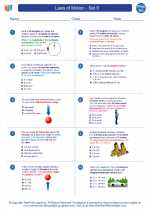The Atom
Atoms are the basic building blocks of matter and the smallest unit of an element that retains the properties of that element. The word "atom" is derived from the Greek word "atomos," which means indivisible, reflecting the early belief that atoms were the smallest particles and could not be divided further.
Structure of an Atom
Atoms are composed of three subatomic particles: protons, neutrons, and electrons.
- Protons: Positively charged particles found in the nucleus of the atom. Each proton has a charge of +1.
- Neutrons: Neutral particles found in the nucleus of the atom. Neutrons have no charge.
- Electrons: Negatively charged particles that orbit the nucleus in specific energy levels or shells. Each electron has a charge of -1.
Atomic Number and Mass Number
The atomic number of an atom is equal to the number of protons in its nucleus. It is represented by the letter Z. The mass number of an atom is the total number of protons and neutrons in the nucleus and is represented by the letter A.
Atomic Structure and Notation
The atomic structure of an atom is often represented in a standard notation known as the atomic symbol. For example, the atomic symbol for carbon is C, and its atomic number is 6, indicating that it has 6 protons. The mass number of an element is often written as a superscript to the left of the atomic symbol, and the atomic number is written as a subscript to the left of the atomic symbol. For example, the atomic symbol for carbon-12 is 12C, where 12 is the mass number.
Isotopes
Isotopes are atoms of the same element that have the same number of protons but different numbers of neutrons. This results in variations in their mass numbers. For example, carbon-12 and carbon-14 are isotopes of carbon, with carbon-12 having 6 neutrons and carbon-14 having 8 neutrons.
Electronic Configuration
The arrangement of electrons in an atom's energy levels or shells is known as its electronic configuration. The electrons fill the shells in a specific order based on their energy levels. The first shell can hold a maximum of 2 electrons, while the second and third shells can hold a maximum of 8 electrons each.
Study Guide
- What are the three subatomic particles that make up an atom?
- Explain the concept of atomic number and mass number.
- Describe the structure of an atom using the atomic symbol notation.
- What are isotopes? Provide an example.
- Explain the electronic configuration of an atom.
[Atom] Related Worksheets and Study Guides:
.◂Physics Worksheets and Study Guides High School. Laws of Motion - Set II

 Worksheet/Answer key
Worksheet/Answer key
 Worksheet/Answer key
Worksheet/Answer key
